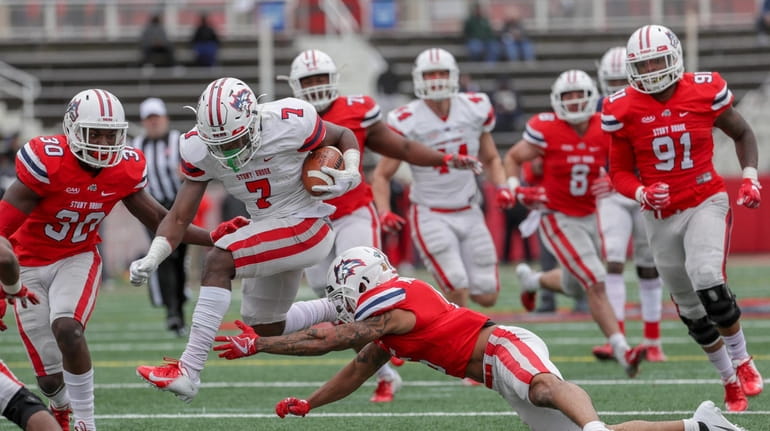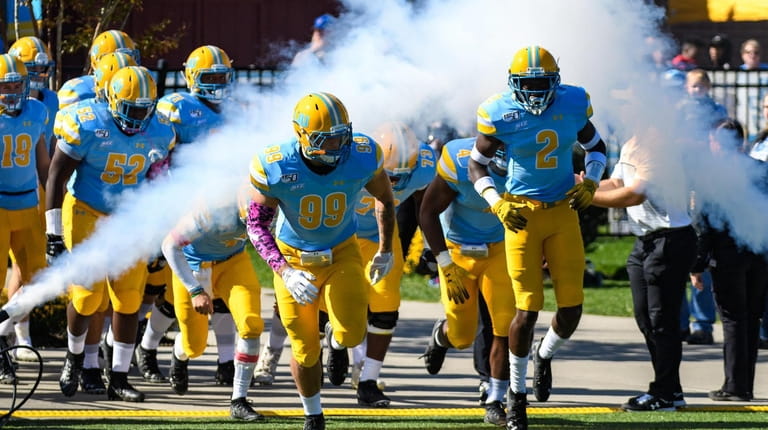Stony Brook, LIU football programs optimistic about immediate, long-term future

Ty Son Lawton #7 of Stony Brook's offensive squad vaults over TJ Morrison #6 of the defensive squad during the spring game at LaValle Stadium in Stony Brook on April 27th, 2019. Credit: Daniel De Mato
Stony Brook is scheduled to kick off its football season on Aug. 29 at Fordham. Long Island University’s opener is slated for Sept. 5 at Montana State. The optimism for both games — and a complete fall season in all collegiate sports across Long Island — is there. Whether the circumstances surrounding the coronavirus pandemic will allow for it remains uncertain.
Colleges and universities are contemplating whether to reopen campuses for the fall semester and what that could look like. Those decisions and the possible timing of campus reopenings will shape the look of college sports on Long Island the most. Without students on campus, there can be no college sports.
“I wouldn’t say we’re confident, but I would say we’re optimistic about the fall season because right now time is on our side in battling the pandemic,” said Joe D’Antonio, commissioner of the Colonial Athletic Association in which Hofstra athletics makes its home and Stony Brook plays football. “The thing is that it may not look like it always has . . . and you’re going to have hills, valleys and pitfalls that have to be negotiated with anything that’s not so-called ‘normal.' "
“There is a lot of game planning for an assortment of scenarios, but we hope everything can go off on time,” said Bill Martinov, athletic director at LIU, which plays in the Northeast Conference. “Most teams in our conference are in the footprint that was hit hardest and we have to see how we’re doing with the virus as we get closer [to the season].”
Martinov explained that any sort of planning for a season will have to include a six-week period for players to train and practice to prepare “for the physical readiness of the student-athletes.”
Given the unevenness of how the COVID-19 outbreak has affected different parts of the country, the CAA has been working up scenarios to make the football season happen. D’Antonio said, “We have looked at one where there are fewer games than the usual eight conference games plus three others — maybe it’s a shorter season with only conference games.”
When asked what would happen if some of the 12 schools in the CAA’s nine-state footprint were not playing football when others were, he said the conference “would have to pivot” but that he’s “confident we can do it.”

LIU Sharks defensive lineman Joe Amalfitano (99) and defensive back Grant Ibeh (2) lead the team on October 19, 2019. Credit: Lee S. Weissman
A shorter football season could impact the fiscal health of college athletic departments. At many football-playing schools, the sport is the biggest generator of the revenue that supports other sports. For many in the Football Championship Subdivision, that not only includes monies from game-day sales (tickets, parking, concessions, etc.) but also guaranteed fees for playing non-conference games against rainmaking football programs. Stony Brook’s Sept. 12 game at Florida Atlantic and LIU’s at Montana State raise major dollars for the athletic budgets of those schools.
Depending on how many weeks there are in a shortened season, there could be an additional financial impact for the schools in the CAA, which has a television deal with FloSports that runs through 2022-23. The CAA is required by contract to provide a certain number of games to air; if they aren’t able to fulfill it “we could see reduced rights fees,” D’Antonio said.
The notion that the season could run later into the year — even into winter — is a lesser concern. The CAA regularly has multiple teams in the NCAA tournaments and many of those contests end up being played in wintry climates.
If one or the other football conferences move the season into the spring, things could look more complicated, especially for CAA football. Consider the facilities. Imagine a football team, two soccer teams and two lacrosse teams all competing for time to practice and play games on one field. D’Antonio said “nothing is off the table.”
Still, both of Long Island’s football programs are determined not to be deterred.
Stony Brook plans to face the facilities challenge, but AD Shawn Heilbron said, “We’d absolutely find a way to play football in the spring. We’d do whatever it takes as long as it’s safe.”
Said Martinov: “It’s a challenge — but we’d make it work.”

